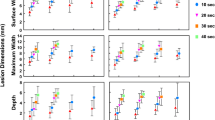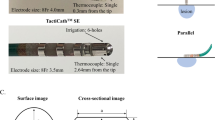Abstract
Background
Certain tachycardias can be eliminated by catheter ablation from within the base of the aortic valve (AV) cusps but the high blood flow and proximity to the coronary arteries create unique challenges. Standard radiofrequency (RF) energy, cooled-tip RF energy or cryothermal energy were compared to determine the optimal ablation modality.
Materials and methods
Experiments were conducted using adult swine or goats (15 animals). Ablation lesions were placed using either: temperature-controlled RF (4 mm-tip catheter; 60°C/60 s), cooled-tip RF (4 mm-tip catheter with internal saline circulation at 0.6 ml/s; 40°C/60 s), or cryoablation (6 mm-tip spot cryocatheter; <−75°C/4 min). Animals were sacrificed 1 h after the last application and lesions were subject to pathological analysis.
Results
Standard RF and cryoablation created similar depth lesions in the right coronary cusp (4.2±1.3 and 3.4±0.5 mm, respectively) but cryoablation was unable to create any visible lesions in the non-coronary cusp. Cooled tip ablation created larger ablation lesions in the right coronary cusp (5.25±0.5) and fully transmural left atrial ablation lesions after ablation in the noncoronary cusp. Acute damage to the cusps was not noted with any ablation modality. Disruption of elastic fibers in the aortic media was seen after standard and cooled tip radiofrequency ablation but not cryoablation.
Conclusion
Cryoablation within the AV cusps created similar sized lesions to standard RF ablation without evidence of elastic fibre disruption and may therefore be an appropriate first line ablation modality. Cooled-tip ablation created larger ablation lesions and therefore may be required if cryoablation is ineffective.
Similar content being viewed by others
References
Hachiya, H., Aonuma, K., Yamauchi, Y., Igawa, M., Nogami, A., & Iesaka, Y. (2002). How to diagnose, locate, and ablate coronary cusp ventricular tachycardia. Journal of Cardiovascular Electrophysiology, 13, 551–556.
Shimoike, E., Ohnishi, Y., Ueda, N., Maruyama, T., & Kaji, Y. (1999). Radiofrequency catheter ablation of left ventricular outflow tract tachycardia from the coronary cusp: A new approach to the tachycardia focus. Journal of Cardiovascular Electrophysiology, 10, 1005–1009.
Krebs, M. E., Krause, P. C., Engelstein, E. D., Zipes, D. P., & Miles, W. M. (2000). Ventricular tachycardias mimicking those arising from the right ventricular outflow tract. Journal of Cardiovascular Electrophysiology, 11, 45–51.
Dixit, S., Marchlinski, F. E. (2001). Clinical characteristics and catheter ablation of left ventricular outflow tract tachycardia. Current Cardiology Reports, 3, 305–313.
Kanagaratnam, L., Tomassoni, G., Schweikert, R., Pavia, S., Bash, D., Beheiry, S., et al. (2001). Ventricular tachycardias arising from the aortic sinus of valsalva: An under-recognized variant of left outflow tract ventricular tachycardia. Journal of the American College of Cardiology, 37, 1408–1514.
Ouyang, F., Fotuhi, P., Ho, S. Y., Hebe, J., Volkmer, M., Goya, M., et al. (2002). Repetitive monomorphic ventricular tachycardia originating from the aortic sinus cusp: Electrocardiographic characterization for guiding catheter ablation. Journal of the American College of Cardiology, 39, 500–508.
Tada, H., Naito, S., Taniguchi, K., & Nogami, A. ( 2003). Concealed left anterior accessory pathways: Two approaches for successful ablation. Journal of Cardiovascular Electrophysiology, 14, 204–208.
Cuello, C., Huang, S. K., Wagshal, A. B., Pires, L. A., Mittleman, R. S., & Bonavita, G. J. (1994). Radiofrequency catheter ablation of the atrioventricular junction by a supravalvular noncoronary aortic cusp approach. Pacing and Clinical Electrophysiology, 17, 1182–1185.
Littmann, L., Svenson, R. H., Chuang, C. H., Kempler, P., Splinter, R., Tuntelder, J. R., et al. (1993). Catheterization technique for laser photoablation of atrioventricular conduction from the aortic root in dogs. Pacing and Clinical Electrophysiology, 16, 401–406.
Pons, M., Beck, L., Leclercq, F., Ferriere, M., Albat, B., & Davy, J. M. (1997). Chronic left main coronary artery occlusion: A complication of radiofrequency ablation of idiopathic left ventricular tachycardia. Pacing and clinical electrophysiology, 20, 1874–1876.
Lustgarten, D. L., Keane, D., & Ruskin, J. (1999). Cryothermal ablation: Mechanism of tissue injury and current experience in the treatment of tachyarrhythmias. Progress in Cardiovascular Diseases, 41, 481–498.
Calkins, H., Epstein, A., Packer, D., Arria, A. M., Hummel, J., Gilligan, D. M., et al. (2000). Catheter ablation of ventricular tachycardia in patients with structural heart disease using cooled radiofrequency energy: results of a prospective multicenter study. Cooled RF Multi Center Investigators Group. Journal of the American College of Cardiology, 35, 1905–1914.
Rodriguez, L. M., Geller, J. C., Tse, H. F., Timmermans, C., Reek, S., Lee, K. L., et al. (2002). Acute results of transvenous cryoablation of supraventricular tachycardia (atrial fibrillation, atrial flutter, Wolff-Parkinson-White syndrome, atrioventricular nodal reentry tachycardia). Journal of Cardiovascular Electrophysiology, 13, 1082–1089.
Dubuc, M., Khairy, P., Rodriguez-Santiago, A., Talajic, M., Tardif, J. C., Thibault, B., et al. (2001). Catheter cryoablation of the atrioventricular node in patients with atrial fibrillation: A novel technology for ablation of cardiac arrhythmias. Journal of Cardiovascular Electrophysiology, 12, 439–444.
Khairy, P., Chauvet, P., Lehmann, J., Lambert, J., Macle L., Tanguay J. F., et al. (2003). Lower incidence of thrombus formation with cryoenergy versus radiofrequency catheter ablation. Circulation, 107, 2045–2050.
Aoyama, H., Nakagawa, H., Pitha, J. V., Khammar, G. S., Chandrasekaran K., Matsudaira, K., et al. (2005). Comparison of cryothermia and radiofrequency current in safety and efficacy of catheter ablation within the canine coronary sinus close to the left circumflex coronary artery. Journal of Cardiovascular Electrophysiology, 16, 1218–1226.
Author information
Authors and Affiliations
Corresponding author
Additional information
This work was supported in part by an NIH K23 award (HL68064-02) to Dr. Reddy and by research grants from Boston Scientific, Inc and Cryocath Technologies, Inc.
Rights and permissions
About this article
Cite this article
d’Avila, A., Thiagalingam, A., Holmvang, G. et al. What is the most appropriate energy source for aortic cusp ablation? A comparison of standard RF, cooled-tip RF and cryothermal ablation. J Interv Card Electrophysiol 16, 31–38 (2006). https://doi.org/10.1007/s10840-006-9006-8
Received:
Accepted:
Published:
Issue Date:
DOI: https://doi.org/10.1007/s10840-006-9006-8




